Diwali, the festival of lights, is a time when homes are decorated with lamps, flowers, and vibrant rangoli patterns. Rangoli, an art form passed down through generations, adds color and positivity to the festive atmosphere. Here are seven Diwali-themed rangoli designs that are easy to create, visually appealing, and perfect for celebrating the festival with family and friends.
1. Traditional Floral Rangoli
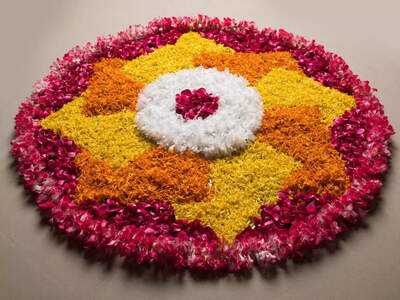
Floral rangolis remain a timeless choice for Diwali. This design uses symmetrical patterns with petals, leaves, and simple geometric shapes. By combining fresh flowers like marigolds and roses, you can create a natural, fragrant decoration that brings a warm and inviting feel to the entrance of your home.
2. Diya-Inspired Rangoli
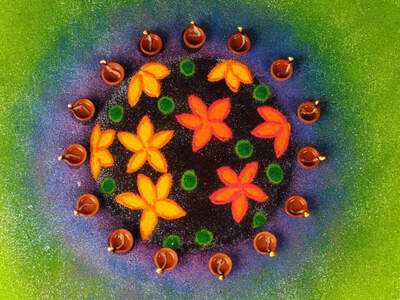
Diwali is synonymous with diyas, and incorporating them into rangoli designs adds a festive touch. These patterns focus on oil lamp shapes at the center, surrounded by vibrant colors and subtle outlines. Lighting real diyas within the rangoli enhances the glow and creates a beautiful harmony of color and light.
3. Geometric Rangoli Patterns

Geometric shapes like squares, triangles, and circles form structured rangoli designs that are easy to replicate. These patterns are ideal for people who prefer neat and precise arrangements. Using bright colors such as red, yellow, and green highlights the symmetry and gives a modern twist to a traditional art form.
4. Peacock-Themed Rangoli
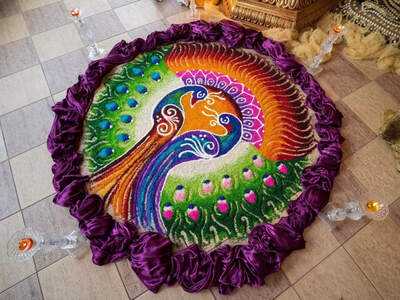
Peacocks symbolize beauty and grace, making them a popular choice for Diwali rangolis. This design often features a stylized peacock with fanned-out feathers, filled with colorful powders and accents. It brings a festive elegance to the floor and is visually striking, making it a favorite for guests and family members alike.
5. Rangoli with Glitter and Stones
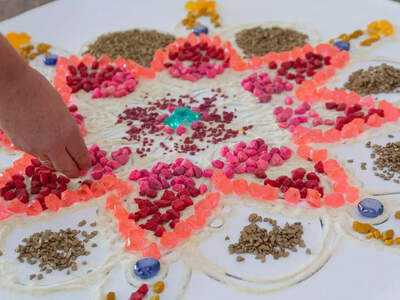
For a sparkling effect, some rangolis include glitter, beads, or small decorative stones. These embellishments make the design shine, especially when placed near lights. Glitter and stones add texture and depth, making even simple patterns appear luxurious and celebratory.
6. Rangoli with Religious Motifs
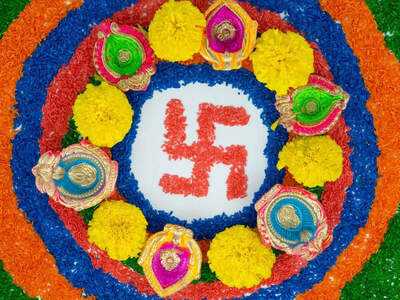
Many Diwali rangolis feature symbols like Om, Swastik, or footprints of Goddess Lakshmi to invite prosperity and positivity. These motifs are often placed at the center, surrounded by decorative patterns. Incorporating religious symbols adds spiritual significance while keeping the design festive and bright.
7. Multi-Layered Color Rangoli

A layered rangoli combines several colors in circular or square patterns, gradually transitioning from one shade to another. This style is visually captivating and allows for creative freedom. Using contrasting and bright colors ensures the rangoli stands out, making it a perfect centerpiece for Diwali celebrations.
Creating rangolis during Diwali is not just about decoration—it is also a way to bring family and friends together. These designs, ranging from simple floral patterns to detailed peacock motifs, reflect creativity, tradition, and the festive spirit that makes Diwali so special.
1. Traditional Floral Rangoli
Floral rangolis remain a timeless choice for Diwali. This design uses symmetrical patterns with petals, leaves, and simple geometric shapes. By combining fresh flowers like marigolds and roses, you can create a natural, fragrant decoration that brings a warm and inviting feel to the entrance of your home.
2. Diya-Inspired Rangoli
Diwali is synonymous with diyas, and incorporating them into rangoli designs adds a festive touch. These patterns focus on oil lamp shapes at the center, surrounded by vibrant colors and subtle outlines. Lighting real diyas within the rangoli enhances the glow and creates a beautiful harmony of color and light.
3. Geometric Rangoli Patterns

Geometric shapes like squares, triangles, and circles form structured rangoli designs that are easy to replicate. These patterns are ideal for people who prefer neat and precise arrangements. Using bright colors such as red, yellow, and green highlights the symmetry and gives a modern twist to a traditional art form.
4. Peacock-Themed Rangoli
Peacocks symbolize beauty and grace, making them a popular choice for Diwali rangolis. This design often features a stylized peacock with fanned-out feathers, filled with colorful powders and accents. It brings a festive elegance to the floor and is visually striking, making it a favorite for guests and family members alike.
5. Rangoli with Glitter and Stones
For a sparkling effect, some rangolis include glitter, beads, or small decorative stones. These embellishments make the design shine, especially when placed near lights. Glitter and stones add texture and depth, making even simple patterns appear luxurious and celebratory.
6. Rangoli with Religious Motifs
Many Diwali rangolis feature symbols like Om, Swastik, or footprints of Goddess Lakshmi to invite prosperity and positivity. These motifs are often placed at the center, surrounded by decorative patterns. Incorporating religious symbols adds spiritual significance while keeping the design festive and bright.
7. Multi-Layered Color Rangoli

A layered rangoli combines several colors in circular or square patterns, gradually transitioning from one shade to another. This style is visually captivating and allows for creative freedom. Using contrasting and bright colors ensures the rangoli stands out, making it a perfect centerpiece for Diwali celebrations.
Creating rangolis during Diwali is not just about decoration—it is also a way to bring family and friends together. These designs, ranging from simple floral patterns to detailed peacock motifs, reflect creativity, tradition, and the festive spirit that makes Diwali so special.
You may also like

"Today when there are different kinds of speed breakers in world, discussion about Unstoppable India is very natural": PM Modi

MP: Firecracker market all set for Diwali fest in Bhopal; focus on safety, green crackers

Traders have started getting Rs 738 crore GST refunds: Delhi CM Rekha Gupta

'To beat India, you cannot rely on ... ': Nasser Hussain warns England ahead of crucial Women's Cricket World Cup fixture

Tripura mulls supplying power to Nepal






